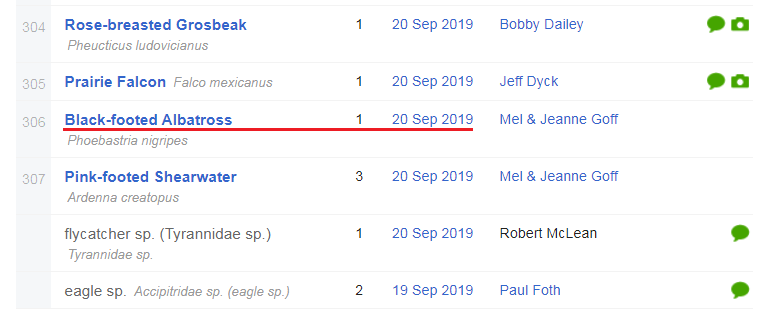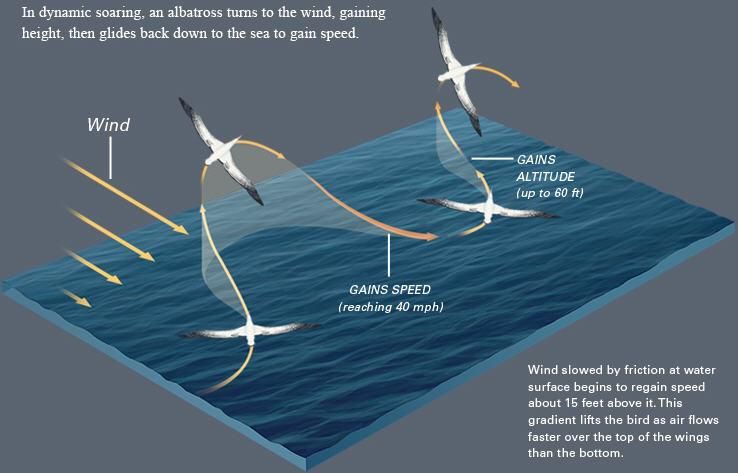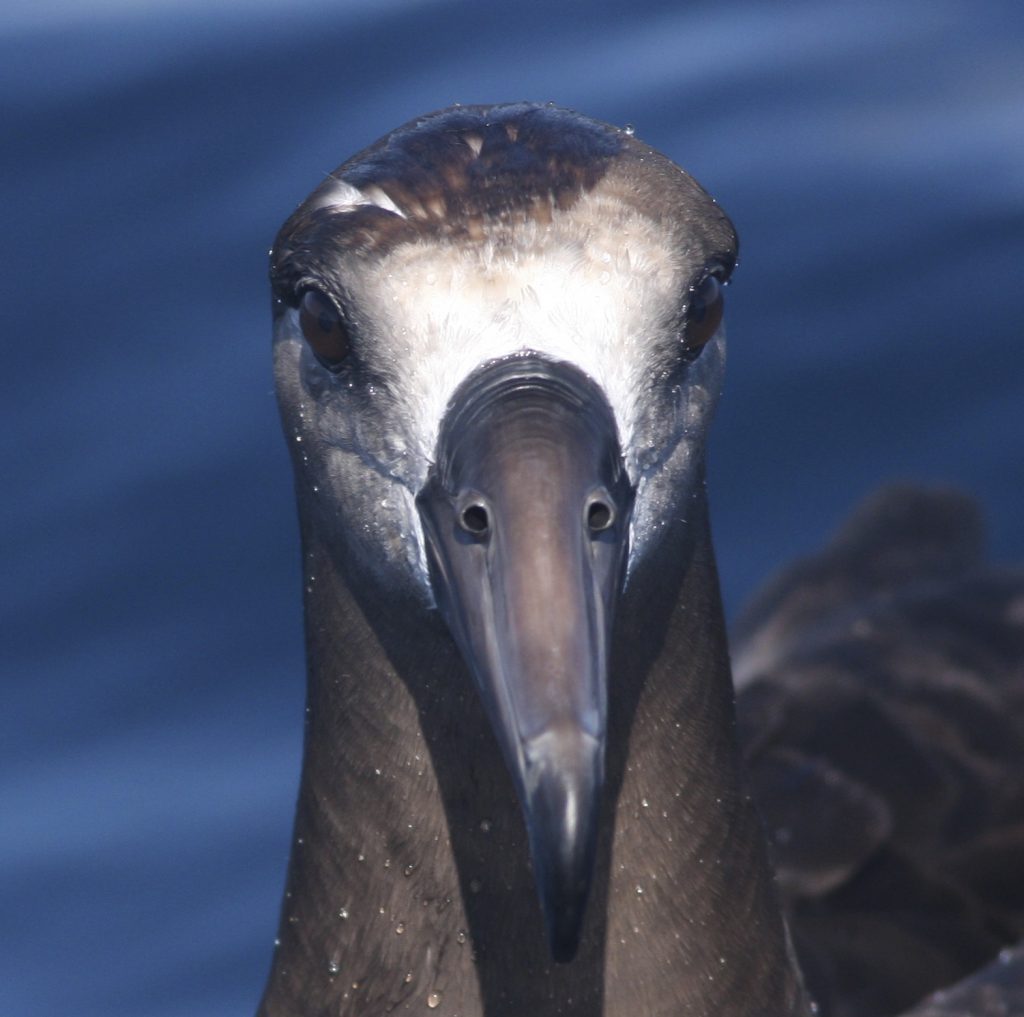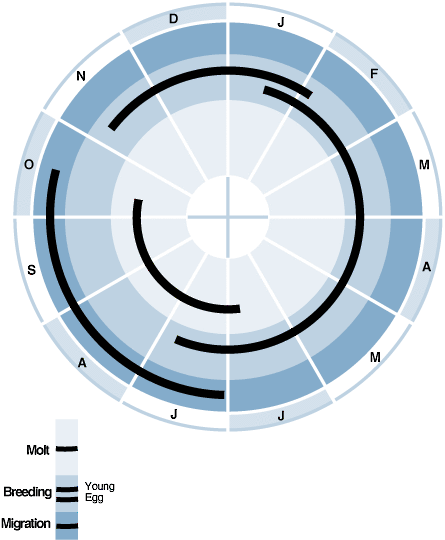The Bird’s Eye View of the BFAL’s Physiology

Black footed Albatross (BFAL) is one of the most magnificent birds to come across if you ever get on a boat to explore the Pacific’s open water. Its wingspan is greater than that of a hawk’s. You will be blown away by its black sleek silhouette rising from just above the waves then soaring high into a gale. It definitely does not live like our familiar sparrow neighbors. We’d better explore what makes this amazing bird the Black-Footed Albatross.

The BFAL has the body length of 64-74 cm and the wingspan of 193-219 cm. The weight ranges from 2.2-4.3 kg (Cornell University, 2017). The black bills with white root and black foot + overall dark brown to grey plumage make this bird relatively easily recognizable from other albatrosses like Laysan Albatross.

If you live in Nanaimo-Parksville area, then you’ll almost never see a BFAL because it is found in marine saltwater environments miles offshore. Its range is extensive as it covers most of the Pacific Northern Hemisphere and parts of the southern; however, most of these birds travel to their breeding grounds; Hawaiian Islands and the small islands off the coast of Eastern Asia (Canada, 2017).


Its average lifespan is about 12-45 years (Cornell University, 2017). Due to the declined population by the cruel human activities in the past decades, IUCN used to categorize the BFAL as “endangered”. However due to the protection efforts, it happily got bumped up to the “near threatened” category in 2018 and numbers are increasing each year, great news! (Avibase, 2019).


Unlike similar sized birds, like the Bald Eagle, BFAL is not quite a vicious aerial hunter nor even an underwater pursuer like a penguin. In the wild, it is mostly the scavenger of the sea (Anderson et al, 2000). It most actively forages during night or early in the morning, looking for prey or floating food near the surface and scoops food out of the shallow water. Its diet consists of fish, fish eggs, squid, crustaceans, and jellyfish (Harrison et at, 1983).
Flying fish spawn on floating debris in a big frenzy, making a big floating mass of their eggs. These eggs are a major part of the BFAL diet and the main staple for fledging chicks during breeding (Harrison et at, 1983).
The BFAL is also seen looking for fish caught in a ship’s wake or squids attracted to the lights of a boat (Anderson et al, 2000). Overall, its peaceful look reflects its attitude.
Breeding and Migration

Breeding of the BFAL begins in November. The BFALs have a courtship ritual of an almost “Spanish Flamenco dance”-like behavior often termed “clattering”. This behavior involves the couple crackling their bills at each other like Castanets followed by a dance that resembles a coupled ballet.

The female can only lay a single egg each year, and the egg hatches in January. The parents take turns in feeding the chick as one looks after it at the nesting sight and the other forages for a period of time to feed and bring back food for the chick. The chick fledges in June-July, and takes about 5-7 years to reach sexual maturity and to gain the full adult plumage (VanderWerf et al, 2019).

After leaving the breeding colony on land in July, the BFAL migrates all across the pelagic waters of the North Pacific for foraging, never to touch the land until next November. Many BFALs migrate around the North Pacific and some of them even reach the Bering Sea up north and the Galapagos Islands in the southern hemisphere (Kentaro et al, 2019).
Towards November, the BFAL will once again migrate back to its home breeding colony to mate. The just-fledged young birds will never set their black feet on the land for the first three years. The birds age four or over begin to come back to the breeding colonies on the islands, but do not nest or mate until they reach sexual maturity (VanderWerf et al, 2019).

The Flight
An Albatross including the BFAL uses its efficient wing design for two special flight skills to greatly boost its mileage. Flapping the wings for propulsion is too energetically costly in covering a long distance. Therefore it relies on wind to build a necessary amount of airspeed over its long, efficient wings to create lift. The lift created from facing the wings into the wind will push the bird up in the sky, and the bird can glide down to the direction where it wants to go, building more airspeed as it descends. Then it will pitch up and use this built up speed again for gaining altitude. This is the “Dynamic Soaring”, the primary skill that the albatross uses to fly.

Image © http://2chicago.weebly.com/

And to further increase the efficiency, the BFAL greatly exploits the wind deflected upward by the ocean waves. And this is called the “Slope Soaring” (or sometimes included as a part of the Dynamic Soaring). If these two cycles are repeated, an albatross can travel up to 1000km/day without even once flapping! (Brooke, 2006)
The problem with this method is that they have a hard time taking off or staying airborne without wind. And flapping to build enough speed for a takeoff requires a painstakingly long takeoff run. When the wind is under ~18km/h speed, they are forced to stay on water (National Marine Sanctuaries, 2017). So you may have seen this bird flying like a pilot with 10000 hours of flying, but their true character is actually a sailor.
Multi-Purpose Nose

Aside from long-distance flight, the BFAL has a keen sense of smell to detect food. Their flight in the wind helps find food better as the wind carries the scent of food a long distance. The BFAL has a habit of chasing plankton bloom where there is a presumably higher chance of finding easy prey at the surface (Freedberg, 2018). Albatrosses are one of the few bird species with a keen sense of smell which enables them to detect food from 20 km away (Anderson, 2008). Sadly, some plastic debris covered in adhering photosynthetic plankton develop the same scent as BFAL’s food. It is suggested that this has been contributing to the BFAL’s ongoing plastic ingestion issue.
The BFAL drinks seawater when thirsty. To prevent up-taking excess amounts of salt and to obtain relatively pure water, it has well-developed salt glands just above the eyes. It is believed that excess salt is extracted in this organ and deposited from the nostrils via ducts connecting them (Freedberg, 2018).


As mentioned previously, wind and airspeed are critical for the flying sailor BFAL. They need to detect and measure the wind. Therefore, albatross’s nostrils are tubed and protrude out of the bills slightly. This allows the albatross to collect the airflow and sensitively measure its speed and direction via the air pressure inside. It is believed that the nasal canal is lined with pressure sensitive nerves (Freedberg, 2018). Humans invented “pitot tubes” almost exactly replicating the albatross’s tube nose thousands years after the albatross evolved to have this feature, and stuck them on almost every aircraft to measure its flying airspeed too.
Precious Fat
The BFAL has a specially modified proventriculus that produces stomach oil consisting of wax esters and triglycerides from the digested lipids. When a parent bird comes back to feed the chick after foraging, it regurgitates the fish and squids mixed with this nutrition-rich fatty material. During the period of a parent catching food for the chick, the chick relies on this cache of fat for growth and survival (Cornell University, 2008). Also this material has a very unpleasant odor which solidifies when spit out to the open air. In some conditions albatrosses use it to turn the predators away (Warham, 1976). For parents, it’s a race of getting their child as fat as possible for the upcoming flight lessons paid only by the student fat loan.

Research: The Black-Footed Albatross’s Decisive Breeding and Molting Strategy

Molting brings the everlasting beauty of birds. Unlike a live skin, a bird feather is a keratin-based dead structure which lacks its ability to maintain and repair itself. Therefore every bird must periodically shed all of their old worn feathers and regrow them through a process called molting. The Audubon society states that molting is essential for maintaining hygiene, color, shape, aerodynamic cleanness, and display of annual reproductive readiness (Jaramillo, 2019)
A normal bird goes through this expensive renovation of the feathers every year. However, the Black-Footed Albatross makes an exception. The BFAL is known to replace the partial sets of its feathers in each year known as incomplete molting, taking more than 2 years to overhaul its feathers.

BFAL’s unique partial molting pattern is most noticeable in the primaries. During the molting, ten primaries are often subdivided in outermost and innermost groups that molt in opposite directions (Langston et al, 1995) and this may mark a measure for how far the bird is into molting.
A team from the University of Washington hypothesized that the BFAL’s energetically expensive molting sequence may be influenced by another equally-expensive reproduction in a form of resource allocation (Rohwer et al, 2011).
.
.
Study Method

The team conducted an observation-based study on the possible relationships between molting pattern and breeding years. The study chose Tern Island in the French Frigate Shoals in two different breeding years of 1998-1999 and 1999-2000 (Rohwer et al, 2011).

To analyze any existence of correlation in molting and reproduction, the study collected data from the actively breeding pairs for 1) age and numbers of the primary feathers replaced and 2) time invested in breeding (“small” for individuals failed in incubation or rearing the chicks early and “large” for individuals that succeeded in fledging or failed in the late rearing). The BFALs that use this location as its home breeding colony have been precisely banded since 1981 to help easily track the ages of the observed birds.
Outcome and Discussion
The team’s analysis found that BFAL replaces the three outermost primaries (P8-10) annually, and the remaining inner primaries (P1-7) undergo intrinsic biannual molting cycle. The 229 adults of even years of age (6, 8, or 10 … years old) replaced average of 4.93 (+_0.103) of their 10 primaries and the 219 adults of odd years of age replaced average of 8.62 (+_ 0.110) of their 10 primaries. In younger year birds especially showed the replacement of P8-10 only in even years, and P8-10 and P1-7 replacements in odd years. Also in some cases, P6-7 which get replaced in the odd year did not molt and went into the third year of use (Rohwer et al, 2011).


In the sampled breeding individuals of the odd age years (which the most of the primaries are replaced), “large” individuals replaced average of 0.9 fewer primaries than the “small” with the more investment in the previous molting. And the about the same pattern is observed for the individuals of the even age years which the “large” individual had replaced fewer primaries than the “small” individuals (Rohwer et al, 2011). This might indicate that replacing all important feathers in one year might be a risky move because molting causes the bird to stay hungrier, decreasing the time and nutrient the chick is going to receive.

The investment spent in one year’s breeding had a significant effect on the likelihood of the bird’s return next breeding year. The individuals which spent “large” investment to the point of fully succeeding in chick fledging or failing late in chick rearing had significant less likelihood of returning to breed next year than the “small” individuals that failed early. The team suggests that individuals that spent large investment in breeding in the previous year are more aware of their need to molt next year. Because the worn feathers (especially the third years in use) greatly decrease the flight efficiency thus the foraging efficiency, the team suggests that skipping of breeding is driven by the need to avoid accumulation of worn feathers(Rohwer et al, 2011).

My Sincere Hope

Black-Footed Albatross is making a recovery from the past devastations such as the past habitat destruction and hunting, it iis classified in the “near-threatened” category facing new threats of pollution and longline fishing (Avibase, 2019). These results help uncover its reproductive cycle and help further assess their recovery rate. Further research with their resource allocation is highly desired for conducting a better restoration program. It is my sincere wish that our effort to understand them and protect them will become fruitful. One day, I would be greeted among the waves by a greatest echelon of happy-feeted Albatross, free of fishhooks and free of plastic.
Did you know……
Bill Nye, our science guy, is developing a scientifically accurate Albatross Flight Simulator! (the game features Short-Tailed Albatross but it’s still too cool to miss!)
References
Cornell University. 2017. Black-footed Albatross Identification. All About Birds, Cornell Lab of Ornithology. Available at: https://www.allaboutbirds.org/guide/Black-footed_Albatross/id.
Environment and Climate Change Canada. 2017. Management plan for the black-footed albatross (Phoebastria nigripes) in Canada. Species at Risk Act Management Plan Series iv(30). Available at: https://www.registrelep-sararegistry.gc.ca/virtual_sara/files/plans/mp_black-footed_albatross_e_proposed.pdf
Black-footed Albatross- Phoebastria nigripes. Avibase. Available at: https://avibase.bsc-eoc.org/species.jsp?avibaseid=EE8ECB1D8652F088.
Anderson, D. J & Fernandez, P, 2000. Nocturnal and Diurnal Foraging Activity of Hawaiian Albatrosses Detected with a New Immersion Monitor. The Condor 102, pp577–584.
Harrison, C. S & Hida, T. S. & Seki, M. P. 1983. Hawaiian Seabird Feeding Ecology. Wildlife Monographs 85, pp3–71.
VanderWerf, Eric & Young, Lindsay & Kohley, C. & Dalton, Megan & Fisher, Rachel & Fowlke, Leilani & Donohue, Sarah & Dittmar, Erika. 2019. Establishing Laysan and black-footed albatross breeding colonies using translocation and social attraction. Global Ecology and Conservation 19, e00667.
Kazama, K & Harada, T & Deguchi, T & Suzuki, H & Watanuki, Y. 2019. Foraging Behavior of Black-Footed Albatross Phoebastria nigripes Rearing Chicks on the Ogasawara Islands. Ornithological Science 18(1), pp27-37.
Hyrenbach, D & Dotson, R.C. 2001. Post-breeding movements of a male Black-footed Albatross Phoebastria nigripes. 29. pp7-10.
Brooke, M. 2006. Albatrosses and petrels across the world. Oxford Univ. Press.
National Ocean Service. 2017. Tracking Albatross Across the Pacific Ocean. National Marine Sanctuaries. Available at: https://sanctuaries.noaa.gov/news/features/0708albatross.html.
Freedberg, W. 2018. How Do Pelagic Birds Find Fresh Water at Sea?. Distractions Displays by Mass Audubon. Available at: https://blogs.massaudubon.org/distractiondisplays/how-do-pelagic-birds-find-fresh-water-at-sea/
Andersen, J. B. 2008. Albatrosses Follow Their Noses. Journal of Experimental Biology 211, pp4-4.
Awkerman, J & Anderson, D. J & Whittow, C. G. 2008. Black-footed Albatross. Cornell Lab of Ornithology; Birds of North America. Available at: https://birdsna.org/Species-Account/bna/species/bkfalb/introduction.
Warham, J. 1976. The Incidence, Function and ecological significance of petrel stomach oils. Proceedings of the New Zealand Ecological Society 24, pp84-93
Jaramillo, A. Understanding the Basics of Bird Molts. Audubon (2019). Available at: https://www.audubon.org/news/understanding-basics-bird-molts.
Langston, N. E. & Rohwer, S. 1995. Unusual Patterns of Incomplete Primary Molt in Laysan and Black-Footed Albatrosses. The Condor 97, pp1–19.
Rohwer, S., Viggiano, A. & Marzluff, J. M. (2011). Reciprocal Tradeoffs Between Molt and Breeding in Albatrosses. The Condor 113, pp61–71.
Hi Hideki,
Great blog, I like that photo from Tofino! 😉 I absolutely LOVE the drawing you did of the Black-footed Albatross for a size comparison. You are a talented artist to say the least! Your use of visual aids was great, and I really liked the photo of the researchers among the albatrosses. How cool would it be to band a Black-footed Albatross! I want that to be me one day!
The research you looked at was incredibly cool. Moult is so neat! The results of the paper are really interesting. Did the paper mention anything about how these birds go about moulting the other remiges (besides the primaries)? If they are moulting their primaries on some kind of cycle, are they possibly also moulting their secondaries in some kind of similar cycle as well?
You also mention in one of your figure captions that the photographed albatross is 17 years old. Do you know up to what age these majestic birds can live? Wisdom the Laysan Albatross is 66 (I think) years old, so I’m wondering how the Black-footed Albatross compares.
Great job on such an entertaining blog,
Sam
Hi Sam. Thank you so much for the comment!
So far the current research only covers the primaries and secondaries with an emphasis on the primaries. I could not find any other research that talks about cycle of the body plumage replacement, (except for ID purposes) . The BFALs can live up to the average of 30-40 years. The oldest I’ve read about is 46 years old! But I believe they can live much longer than that. Also Thank you very much for providing me with the video and photo from our region too! An absolute beauty!
Just for the sake of accuracy; Nanaimo does actually have at least one record of Black-footed Albatross.
There are many hundreds of thousands of bird records for the Nanaimo area which have never been entered into eBird. 🙂
Hi Guy. Thank you for your comment!
Thank you so much for your info! I’m very exited to hear that the Albatross can be seen in Nanaimo/Ladysmith area if lucky enough!
It gives me a lot of hope of myself seeing one sometime, maybe off from the BC Ferry deck or something.
I’ve updated my blog to your additional info!
(I’ve replied to your comment actually weeks ago. But since it was the first comment I replied, I did not notice the connection error and it did not get posted. I’m sorry about this inconvenience.)
Hi Hideki,
I learned so much reading this blog. Thank you for taking the time to do this awesome bird justice. Their adaptations to this lifestyle are incredible! I especially appreciated the part about fattening up the chicks. So cool that they can use the regurgitations to ward off predators. Imagine if humans did the same…
I had a question about their conservation status. You briefly mentioned that cruel human activity has caused a declining population of black-footed albatross in the past. What did we do and how have we changed? Mainly, how can we make sure we don’t destroy albatross populations in the future?
Again, great job!
Cheers,
Hi Shenade. Thank you so much for reading this blog to the end!
The BFAL’s/albatross habitat usually has a very limited predators. However gulls and jeagers still attack chicks and eggs. Their regurgitated oil solidifies on the feathers of these birds causing multiple harms including: bad smell, loss of buoyancy, and reduced reproductive attractiveness of the bird due to its smell and sticky looks. So it does cause some devastating effects to the birds that tired to mess with the albatross.
For the threat/conservation question, it has a lot to talk about. In the past, European and Western feather-collecting in 19th-20th century hunted a lot of the BFALs. And Asian boats hunted these birds for food destroying their colonies. Rats were also introduced during these times and ate the eggs, chicks, and brooding parents (still on-going to this day). And during the Pacific War, their breeding atolls were paved into airfields and shipdocks. Even the remaining birds nearby the airfields were eradicated to avoid collisions with their warplanes… So a lot of things happened.
Currently, plastics ingestion and long-line fishing are the major threat. Plastics accumulate in the BFALs and kill their bird by malnutrition. And the long-line fishing bycatches the BFAL. Rats still on the atolls are doing some nasty damage too.
For conservation: Long-line fishers are beginning to use better designed lines that reduces bycatches. And rad eradication is in operation too. And most importantly, the artificial relocation of the colonies to much safer islands (less fishing nearby and predator-free) have been successful. The plastic pollution is still a tough one to solve… But I hope reduced pollution or the clean-up operation will prove effective in the future…!
Hi Hideki,
This is such a great article! Your drawing of an albatross was so good and such a great way to appreciate how long their wingspan is! The video you’ve included of their “clattering” dance was very interesting to watch! I was just wondering if you’ve read anywhere about how long pairs of albatrosses will stay together, do they mate for life or find new partners after each breeding season?
Thanks!
Gen.
Hi Genevieve! Thank you for your comment!
Albatrosses in general mate for life. Upon the fledgling, the potential pair spends years getting to know each other at the breeding colonies until the sexual maturation. I’m not sure about the BFAL’s case (I could not find the detailed source), however some albatross species have been known not finding another partner if one of the mate dies. So I think the most of the case they mate for more than 30+ years till they die of old age.
Hi Hideki,
I didn’t know a lot about Albatrosses before reading your article. It was really informative, and your drawing of the albatross is incredible! I’ve definitely got a greater appreciation for these amazing birds now.
I couldn’t help but think about the Blue-Footed Booby while reading your blog, which deposits pigments obtained from its diet (small fish like anchovies) in it’s feet to create the bright blue colour. Does the Black-Footed Albatross have black feet for the same reason?
Thanks,
Sarah
Hi Sarah. Thank you for your comment!
I am not fully sure about why their feet are black pigmented. The color comes from melanin, and many cases in birds use various pigments in their legs for sexual selection and mate identification. Usually, Albatross plumage color takes an advantage of the countershading thus camouflage, but the recent researches also say that the darker body also creates a small thermal convection current on the surface of the bird which lifts the bird slightly. So having a dark overall cover might actually help in a way of its flight. It’s good to note that black color hides its legs into the shade of the body if looked from below, making it look more like a big surface debris and not a moving paddling bird too.
Hey Hideki, this was a really interesting blog, and I had no idea about the strange molting habits these guys exhibit. You mentioned that the black footed albatross will look for fish left in the wake of ships, do you know if they will actively seek out ships or if they are just attracted to the smell of fish using their special shnoz?
Hi John. Thanks for the comment!
Many seabirds learn to follow various ships because their wake sometimes provides an easy catch of fish. Birds that are heavily dependent on the eyesight can visually find the boat and even can identify the type of the boat(eg. distinguish if the boat is a commuter or trawler). I think that similarly, the BFAL uses its vision and sense of smell to find the boat as this combination will maximize the efficiency. Also seabird like these seem to use the boat’s turbulence and waves for their flight too, like the goose’s formation flight, making it easier to fly.
Hi Hideki!
I learned about albatross in elementary school during a discussion about their wingspans compared to other birds. I was amazed by your drawing of the BFAL and comparing its wingspan to your own. I once heard albatross (no specific species named) have the largest wingspan of all birds. I was wondering if you knew whether this was true or not? If it is, it would be interesting to see which species holds the record and how BFAL compares!
Thanks for an informative read! Job well done,
Melissa
Hi Melissa. Thank you for reading my blog!
That is true! The bird with the largest wingspan is indeed the Wandering Albatross with 350cm across. The second longest-wingspaned is the Andean condor with 320cm across. The Black-footed albatross is sometimes referred as “small” sized albatross still. The known smallest albatross is the Indian Yellow-nosed Albatross, but its wingspan can still reach 200cm.
Hideki